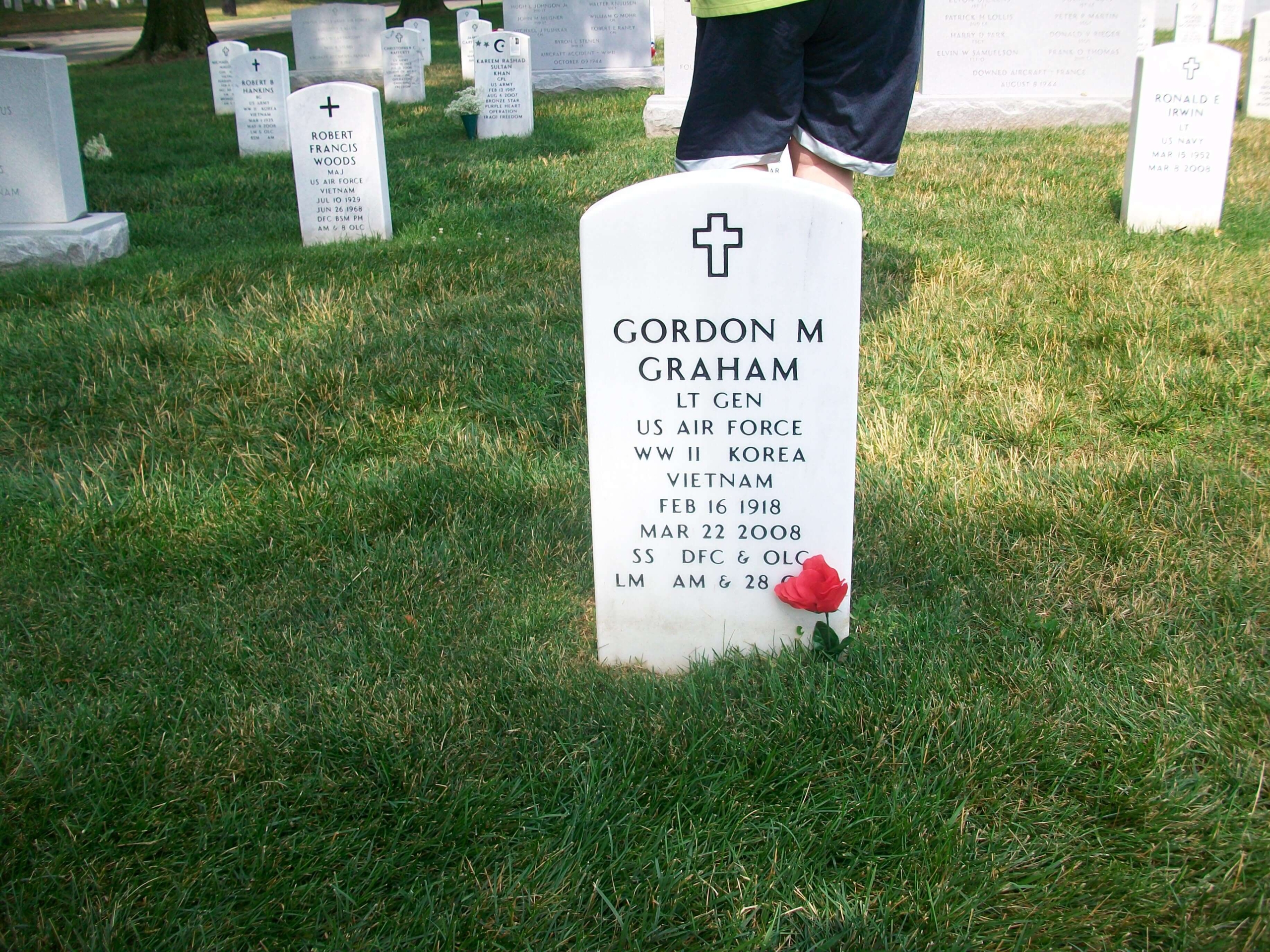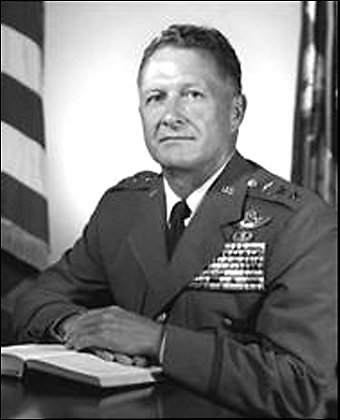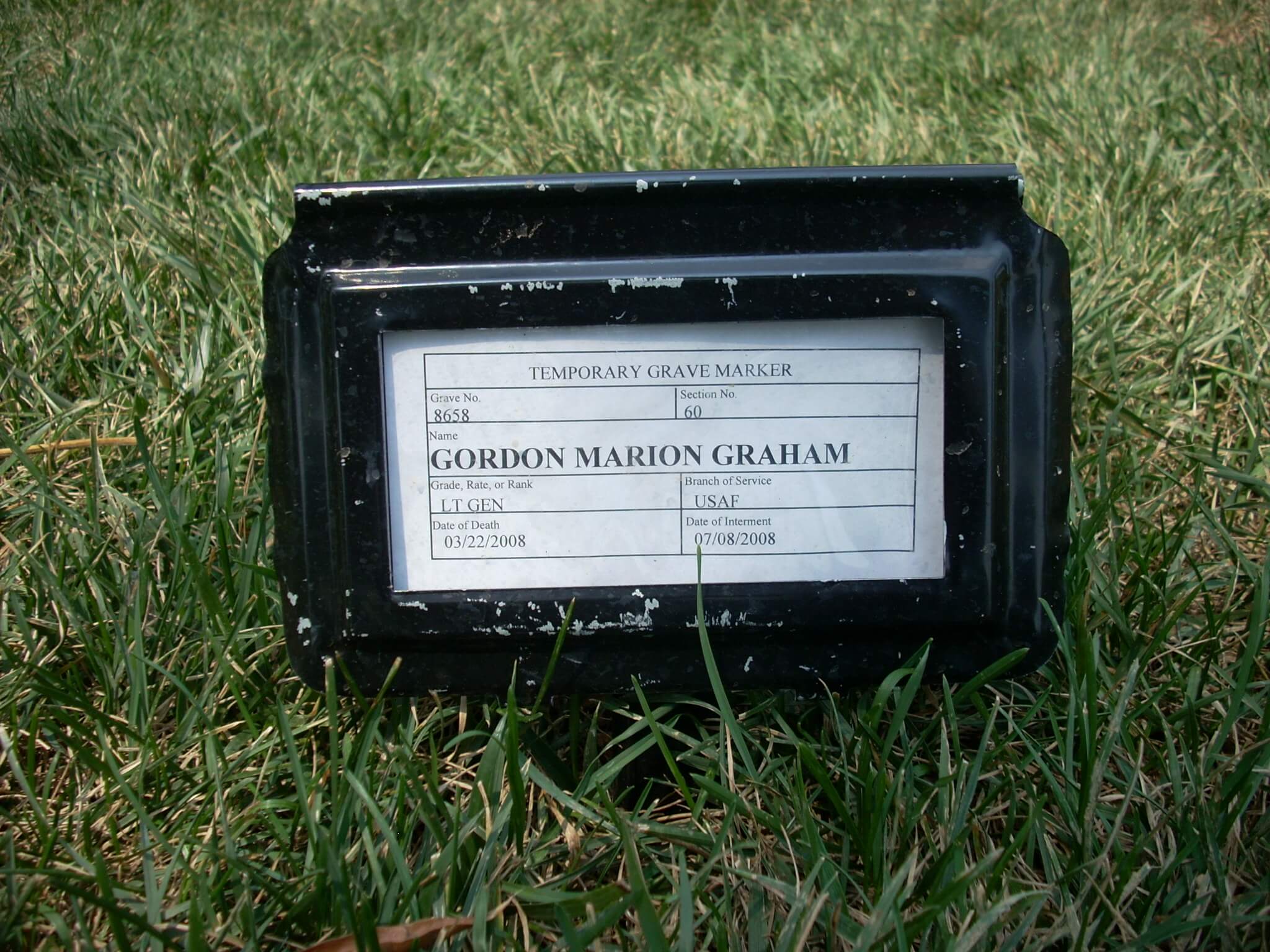LIEUTENANT GENERAL GORDON M. GRAHAM
Retired July 1, 1973. Died March 22, 2008.
Lieutenant General Gordon M. Graham was commander of the Sixth Allied Tactical Air Force with headquarters at Izmir, Turkey. As commander he was responsible for NATO air forces from the United States, Greece and Turkey and carries out a threefold mission of support for the Allied counterair campaign, provision of air defense for the Southeastern NATO Region, and conduct of tactical air operations in support of ground forces in the SIXATAF area of responsibility.
General Graham was born in Ouray, Colorado, in 1918. He attended Taft High School in Taft, Calif. and graduated from the University of California in 1940 with a bachelor of science degree in petroleum engineering. He began his military career in December 1940 as an aviation cadet and was commissioned as Second Lieutenant and received his pilot wings upon completion of flying school in August 1941.
After a series of assignments as gunnery instructor and instructor pilot at various bases, General Graham joined the 355th Fighter Group in the Eighth Air Force in Europe in August 1944. He commanded the 354th Fighter Squadron from October 1944 until June 1945 when he was transferred to the 361st Fighter Group to command the 374th Fighter Squadron. He assumed command of the 361st Fighter Group in August 1945.
By the end of World War II in Europe, General Graham had flown 73 combat missions in P-51 Mustang fighter aircraft and had become a triple ace with 16 1/2 enemy airplanes to his credit. In addition, he had one probable and 10 damaged. He was assistant chief of staff for operations, VIII Fighter Command, from October 1945 until February 1946.
After four months as a civilian with the Socony Vacuum Company of Venezuela, he returned to active military duty with the U.S. Army Air Corps in September 1946 as deputy assistant for operations, Tenth Air Force, at Brooks Field, Texas. He later served as commander of Reserve training detachments at Brooks and Carswell fields, Texas.
In 1947 General Graham entered the University of Pittsburgh under the Air Force Institute of Technology program, earning a master of science degree in 1948. In his next two assignments, General Graham was industrial mobilization training consultant to the Union Oil Company of California and the Shell Oil Company.
Between September 1949 and December 1954, General Graham served as chief of the Target Analysis Division in the Office of the Director of Intelligence at Headquarters U.S. Air Force and then as director of targets in the Directorate of Intelligence, Headquarters Far East Air Forces, Japan.
General Graham returned to the United States in January 1955 and served first as deputy commander and then from October 1955 as commander of the 31st Strategic Fighter Wing at Turner Air Force Base, Ga. As commander, he performed the navigation for his wing's lead element during “Operation Left Hook,” a Strategic Air Command fighter wing bombing and navigation competition. The 31st Strategic Fighter Wing won the navigation and maintenance trophies and took second place honors among the seven wings entered in the competition.
General Graham also led a series of F-84F jet aircraft “Oil Burner” missions which demonstrated that nonstop air refueled, day and night long-range deployments in fighter aircraft were practical. In 1958 he led the first nonstop deployment of F-100 aircraft from the United States to Europe, and also he was captain of the 31st Tactical Fighter Wing team which won the Tactical Air Command Fighter Weapons Meet and placed second in worldwide tactical fighter weapons competition.
In January 1959 he returned to Headquarters U.S. Air Force as chief of the Tactical Division and later was director of operational forces in the Directorate of Operations. In July 1962 he went to Seymour Johnson Air Force Base, N.C., to command the 4th Tactical Fighter Wing and in October 1963 was named vice commander of the Nineteenth Air Force. General Graham moved to Langley Air Force Base, Va., in November 1964 to become a member of the Headquarters Tactical Air Command staff. He served as Deputy for Operations from August 1965 to July 1966.
He next went to Southeast Asia and assignment as vice commander of the Seventh Air Force where he flew 146 combat missions in F-4 and RF-4 aircraft. He returned to the United States in August 1967 to become commander of the Ninth Air Force at Shaw Air Force Base, S.C. In August 1968 General Graham returned to Langley Air Force Base as vice commander, Tactical Air Command.
General Graham was assigned as commander, U.S. Forces Japan, and commander, Fifth Air Force, with headquarters at Fuchu Air Station, Japan, in February 1970. At the conclusion of this tour of duty, he was awarded the Order of the Sacred Treasure, First Class, by Japan, and the Order of National Security Merit Gug-Seon Medal by the Republic of Korea. In November 1972 he was assigned to Izmir, Turkey, as commander, Sixth Allied Tactical Air Force.
For his service in the Republic of Vietnam, General Graham was awarded the Distinguished Service Medal. He has also earned the Silver Star; Legion of Merit; Distinguished Flying Cross with oak leaf cluster; Air Medal with 27 oak leaf clusters; Joint Service Commendation Medal; Air Force Commendation Medal; Republic of Korea Order of Military Merit; National Order of Vietnam, 5th class; Vietnamese Air Force Distinguished Service Medal, 1st class; the Vietnamese Armed Forces Honor Medal, 1st class; Vietnamese Air Force Pilot Wings; Republic of Korea Air Force Pilot Wings; and Chinese Air Force Pilot Wings.
General Graham was a command pilot who, in accruing 9,000 flying hours, has flown all of the U.S. Air Force century series jet fighters including the F-111A and comparable U.S. Navy fighter aircraft such as the A-7A. He completed the U.S. Army Airborne Parachutist Course in 1962 and is jump qualified.
General Graham is a member of Tau Beta Pi, the national honorary engineering society; American Institute of Mining, Metallurgical and Petroleum Engineers; American Fighter Aces Association; Red River Valley Fighter Pilots Association; Order of Daedalians; Air Force Association; and a life member of the National Rifle Association.
Gordon M. Graham, 90, a retired Air Force Lieutenant General who destroyed more than 16 enemy aircraft in World War II to become a triple ace, died of a stroke March 22 at his home in Irvington in Virginia's Northern Neck.
General Graham logged 9,200 hours in 78 types of aircraft, including 73 combat missions in P-51D Mustang fighters in Europe and 146 combat missions in Southeast Asia.
He first went overseas in 1944 and was credited with 16 1/2 kills, one probable and 10 damaged enemy aircraft.
His last assignment before retiring in 1973 was as commander of the Sixth Allied Tactical Air Force in Izmir, Turkey, responsible for NATO air forces from the United States, Greece and Turkey.
After he left the military, he worked for McDonnell Douglas Corp. as president of its Tokyo office.
In 1978, he returned to Washington, where he was the firm's corporate vice president until 1983, when he retired.
He was born in Ouray, Colorado, and moved with his family to Taft, California, as a child. He graduated from the University of California at Berkeley.
He served in World War II as commander of the 354th Fighter Squadron, 355th Fighter Group, Eighth Air Force at Steeple Morden, England. He was credited with more than 1,000 combat hours in fighters from World War II through the Korean and Vietnam wars.
He received a master's degree in petroleum engineering from the University of Pittsburgh in 1948. He then became the Air Force industrial mobilization training consultant to the Union Oil Co. of California and the Shell Oil Co.
In addition to his flight positions, he served as chief of strategic target analysis for the Korean War and led the first nonstop transatlantic deployment of F-100 fighters.
As commander of the Fifth Air Force and U.S. Forces Japan, General Graham was instrumental in the planning and signing of the Okinawa reversion treaty.
Among his military awards were the Distinguished Service Medal, the Silver Star, the Legion of Merit, two Distinguished Flying Cross honors and 28 Air Medal decorations.
After retiring from McDonnell Douglas, he moved to the Northern Neck, where he volunteered for the local rescue squad and animal welfare league.
He also wrote his autobiography, “Down for Double: Anecdotes of a Fighter Pilot” (1996).
His marriage to Dorothy Huntingdon Graham ended in divorce.
Survivors include his wife of 40 years, Vivian Fox Graham; three children from his first marriage, Eloise Graham Brooks of McLean, Helen Huntingdon Stubbs of Merritt Island, Fla., and Gordon Alexander Elting Graham of Gig Harbor, Wash.; two stepsons, Robert Earl Fairbairn of Williamsburg and Donald Boyce Fairbairn of Darnestown; 10 grandchildren; and three great-grandchildren.
Loeutenant General Gordon M. Graham logged more than 9,000 flying hours during his career in the Air Force.
General Gordon M. Graham's first experience flying a plane came while he was working as a teenager at an airport in California in the early 1930s.
One payday, he was told there wasn't enough money to pay him. He was asked if he would like a flying lesson instead, said his wife of 40 years, Vivian Fox Graham of Irvington.
That first experience piloting a plane became a passion for General Graham, who became a triple ace during World War II by destroying at least 16 enemy planes and who logged more than 9,000 flying hours during his career in the Air Force.
“He had a fantastic career. It was far more exciting and interesting than anything else,” his wife said.
General Graham, who retired from the Air Force in 1973 as commander of the 6th Allied Tactical Air Force in Izmir, Turkey, died Saturday at Rappahannock Westminster-Canterbury after suffering a stroke in February. He was 90.
He was born in Ouray, Colorado, and grew up in Taft, California. He graduated from the University of California at Berkeley — where he was a lightweight Golden Glove champion — with a bachelor's in petroleum engineering. He joined the military in December 1940 and received his wings in August 1941.
By the end of World War II, he had flown 73 combat missions in P-51 Mustang fighter planes. He also saw combat in Korea and Vietnam, being credited with more than 1,000 combat hours in fighters.
During his career, he held various posts in the Air Force and received 55 decorations and service awards, including the Distinguished Service Medal and Silver Star.
Proud of those honors, General Graham displayed them in a framed box on a wall, his wife said.
After leaving the military, General Graham worked for McDonnell Douglas Corp., first as president of its Tokyo office and then as corporate vice president in Washington.
Upon retiring in 1983, General Graham and his wife moved to the Northern Neck, where he volunteered with the rescue squad, the free health clinic and the Animal Welfare League.
In 1996, he published an autobiography, “Double for Down: Anecdotes of a Fighter Pilot.”
In addition to his wife, survivors include two daughters, Eloise Graham Brooks of McLean and Helen Huntingdon Stubbs of Merritt Island, Florida; a son, Gordon Alexander Elting Graham of Gig Harbor, Washington; two stepsons, Robert Earl Fairbairn of Williamsburg and Donald Boyce Fairbairn of Darnestown, Maryland.; 10 grandchildren and three great-grandchildren.
A memorial service will be held April 4 at 11 a.m. at Campbell Memorial Presbyterian Church, 3712 Weems Road, in Weems. Burial will be July 8 at 1 p.m. at Arlington National Cemetery.
GRAHAM, GORDON MARION
- LT GEN US AIR FORCE
- WORLD WAR II, KOREA, VIETNAM
- DATE OF BIRTH: 02/16/1918
- DATE OF DEATH: 03/22/2008
- BURIED AT: SECTION 60 SITE 8658
- ARLINGTON NATIONAL CEMETERY

Michael Robert Patterson was born in Arlington and is the son of a former officer of the US Army. So it was no wonder that sooner or later his interests drew him to American history and especially to American military history. Many of his articles can be found on renowned portals like the New York Times, Washingtonpost or Wikipedia.
Reviewed by: Michael Howard


